Essential Guide to Rocky Mountain National Park Photography + How to Photograph the Best Locations
Rocky Mountain National Park photography dates back to the park’s earliest days when US President Woodrow Wilson signed the act that created the park in 1915. Over the decades, photographers, including renowned landscape photographer Ansel Adams, have flocked to Rocky Mountain for the opportunity to photograph its iconic landscapes and wildlife.
The dramatic alpine scenery of Rocky Mountain National Park lends itself to countless compositions and subjects for nature photographers. Whether your goal is to photograph some of the tallest peaks in North America, like 14er Longs Peak, or the fall elk rut, a photography trip to RMNP is a bucket list item for any photographer.
Where are the best photo spots in Rocky Mountain National Park? With so many options for photography locations to get that perfect shot in Rocky Mountain National Park, it can be hard to know which are most worthwhile.
In this photographer’s guide to Rocky Mountain National Park, we outline the best photo location spots, views, and landmarks throughout the park. We also share our top tips for capturing the perfect photos in RMNP based on our years of photography experience in the park!

Best Rocky Mountain National Park Photography Locations
Rocky Mountain National Park is teeming with spectacular views of the towering peaks that comprise the Continental Divide. Nestled among the mountains are countless alpine and sub-alpine lakes, dozens of waterfalls, and hundreds of species of wildlife, all of which make outstanding subjects for photographers in Rocky Mountain National Park.
Here are the 10 best photo locations in Rocky Mountain National Park:
Bear Lake
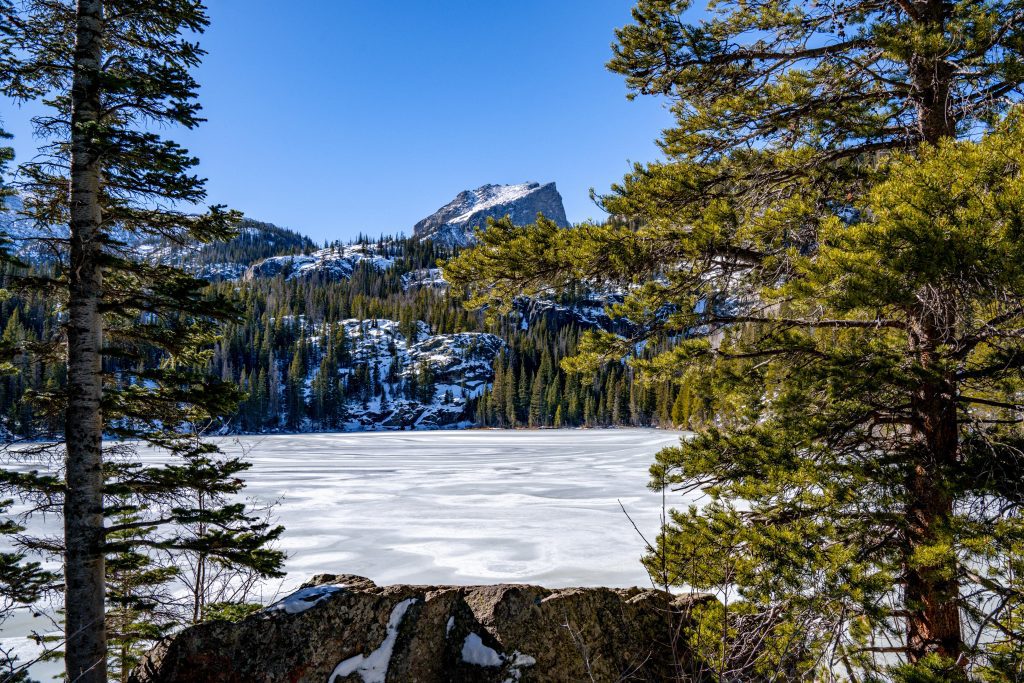
Bear Lake is a Rocky Mountain National Park icon. This lake is easy to access, only requiring a short walk from the parking lot to reach. There is a relatively flat trail circumnavigating the lake, providing plenty of vantage points for capturing Hallett and Flattop Mountains, as well as Long’s Peak. On summer nights, this is a good place to photograph the Milky Way. On a still day, you can catch a great reflection of the peaks in Bear Lake’s water. It’s a great place to photograph during sunrise when the light hits Hallett and Flattop Peaks.
Sprague Lake
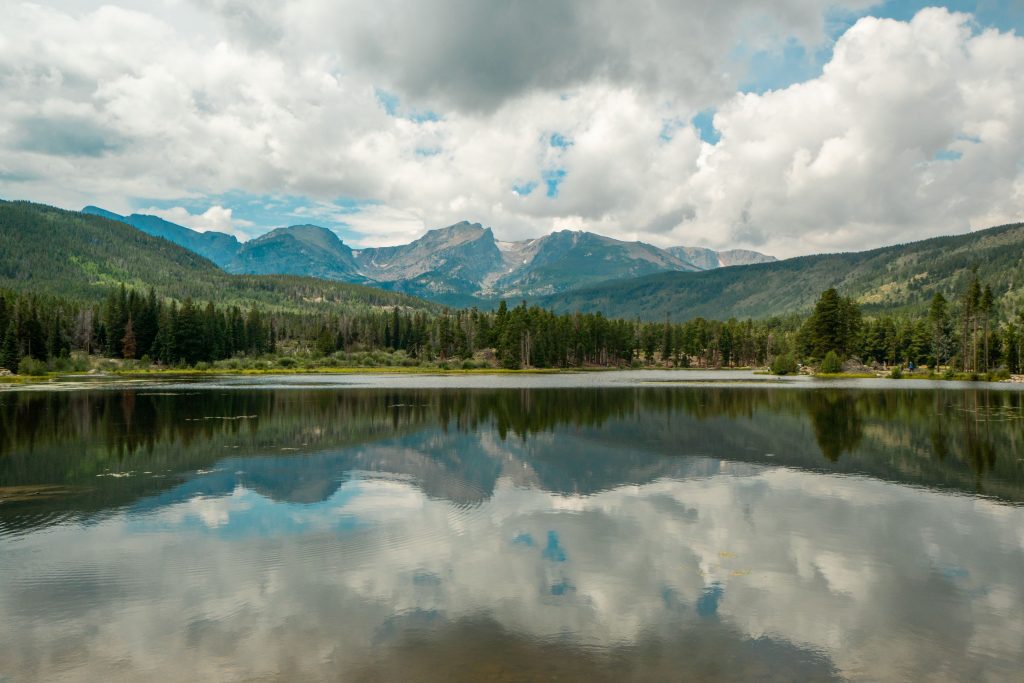
Another easy-to-access photography spot, Sprague Lake is beautiful any time of the day, but especially at sunrise or in the morning when the light hits the peaks. Sprague Lake offers one of the grandest views of the Rocky Mountains that comprise the Continental Divide. The best view is along the loop trail around the lake. Look for a little wooden pier for a great photo op squared up beneath the peaks.
Emerald Lake
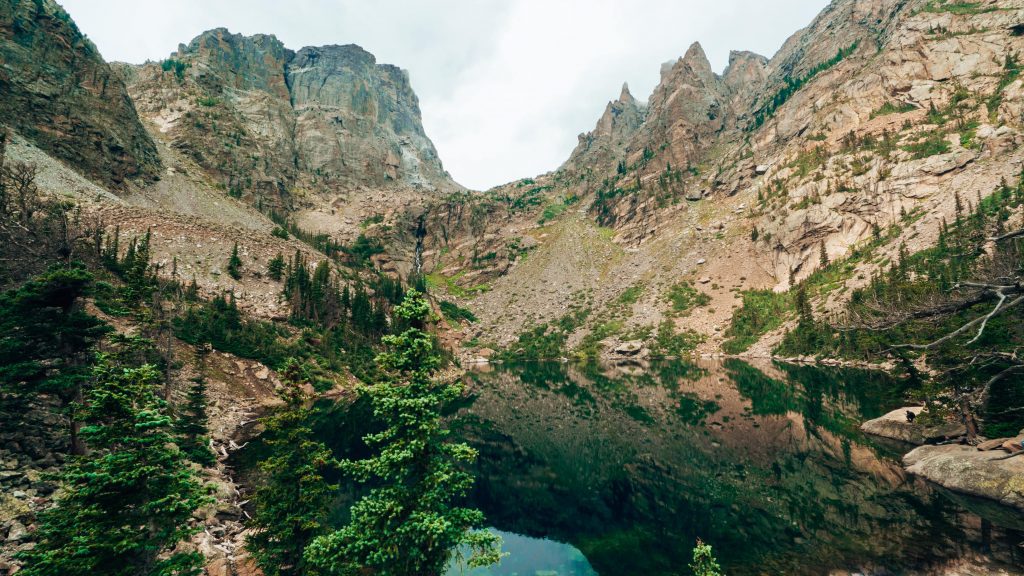
One of the most popular destinations in Rocky Mountain National Park, Emerald Lake requires a 3.5 miles hike round trip. Bring a wide lens for Emerald Lake to capture it fully. Because of how close the lake is to the mountain peaks, you will have a hard time getting the full landscape in your frame with a prime lens or telephoto lens. The best photo spots at Emerald Lake are on the rocks to the right of the trail when you arrive a the lake, or a short scramble up the pile of rocks to your left. For a higher vantage point over the lake, follow the spur trail up a rock scramble to your left up on a ridge. It’s a tricky scramble to get up there. Only attempt if you are comfortable and capable! In winter, you can walk out on the lake, which makes for a great composition if you want to get a photo of yourself or others at Emerald Lake.
Lake Haiyaha

If you photographed Lake Haiyaha before 2022, you need to go back! In the summer of 2022, a rockslide deposited silt into the lake, turning it a milky aqua blue color. Geologists don’t know how long the lake will remain this color, so we recommend going soon if you want to photograph the most unique lake in RMNP.
Dream Lake

One of the most picturesque spots in all of Rocky Mountain National Park, Dream Lake lives up to its name. Set beneath an impressive view of Hallett Peak and Flattop Mountain, Dream Lake frames up a beautiful composition. For the best view, venture to the rocky beach-ish area to the left of the trail. If it’s crowded, hug the rocky shoreline to the right past the big boulder until you’re under the tree. Most people don’t venture to this spot, despite it providing a great view of the lake. For a higher vantage point, you can also climb up the boulder for some photos, but I find this angle a little tricky to capture my desired framing of the peaks behind the lake.
Nymph Lake

I always skipped stopping at Nymph Lake on my trips to Rocky Mountain National Park, which I know now was very foolish of me. On a still and quiet morning, you can capture beautiful reflections of the mountains in the lake with a moody mist hovering over the water. Although the mountain view isn’t as dramatic as that at Dream Lake or Emerald Lake, Nymph Lake has a quiet beauty that is well worth the stop. Plus, the lake is dotted with lily pads which provide a bit of foreground and contribute to more depth in your composition.
Loch Vale

Loch Vale is one of the prettiest views in RMNP in my opinion. For the best view, follow a spur trail to the left when you get to the lake. There is a little peninsula of land that juts out into the lake, which is a great place to put your subject. It’s also a good spot from which to shoot pictures as it provides a good angle of the mountains. We also like the view from the trail just to the right of the lake when you arrive. Don’t go too far along the trail to the right, though, as it goes into the forest and you’ll lose your view!
Alberta Falls

If you are hiking to Loch Vale, be sure to stop at Alberta Falls for photos. These falls are best photographed early in the morning before the crowds arrive. Set your tripod up on the rocks in front of the 30-foot tall waterfall for a good angle looking directly at the falls. If it’s bright out, use a neutral density filter so you can set an extended exposure for the silky smooth water effect in your photos. We also recommend using a remote shutter so you can minimize the camera shake caused by manually pressing the shutter button. With a longer exposure, it’s important that your camera be as still as possible and that everything in your photo (except for the water of course) also remains still.
Trail Ridge Road

There are many excellent photo ops on Trail Ridge Road. We especially like Forest Canyon Overlook, Gore Range Overlook, and the view from the top of the Alpine Ridge Trail. You have a good chance of spotting wildlife like big horn sheep, elk, and moose on Trail Ridge Road as well, so if wildlife photography is of interest to you, this is a great place to be. We’ve heard that the Rainbow Curve Overlook is a beautiful spot for photos, as well, but it was shrouded in fog the last time we went! Note that Trail Ridge Road is closed from October until summer. Exact dates vary each year based on when the snow arrives for the winter and melts for the summer, so be sure to check the official national park website for dates.
Moraine Park

Moraine Park has one of the prettiest views of the Rocky Mountains, towering over a lovely meadow where you can frequently spot elk. Plus, this is one of the easiest places to get to in RMNP. It requires no hiking and is the first spot you will come to on Bear Lake Road. Because it is so easy to get to, it’s a good contender for sunrise photos, as well.
Map of Rocky Mountain National Park Photography Locations
Best Seasons for Rocky Mountain National Park Photography
No matter what time of year you choose to photograph Rocky Mountain National Park, you will find ample beauty as unique as the seasons. Summer is generally the best time to take pictures in Rocky Mountain National Park because Trail Ridge Road and Old Fall River Road are only open in summer. Here are some tips for Rocky Mountain National Park photography whatever season you go!
Summer Tips for Rocky Mountain National Park Photography
Summer is a fantastic time to photograph Rocky Mountain National Park. You will be able to capture pictures of the many wildflowers in the park. You will also be able to photograph locations on Trail Ridge Road and Old Fall River Road, which are closed every other season of the year. The one downside is that this is the busiest season in the park with the heaviest crowds. Between May and October, you will need to obtain a timed entry permit to enter the park. Even with the timed entry system, parking lots fill up quickly in the summer, and if you don’t get to your destination early enough to get a spot, you may need to take the free park-and-ride shuttle, which will limit your ability to stop and photograph as you wish.

Spring Tips for Rocky Mountain National Park Photography
Spring is the best time of the year to photograph baby animals, like elk, moose, and big-horn sheep. You can also photograph the earlier wildflowers. Trail Ridge Road and Old Fall River Road remain closed, so you won’t get to visit those locations. On the upside, crowds aren’t yet in full swing, and you don’t need a timed-entry permit.

Fall Tips for Rocky Mountain National Park Photography
Rocky Mountain National Park is a beloved photography destination for fall colors, especially the yellow aspens throughout the park. Of course, this also means the park stays pretty crowded in the fall. Mid-to-late September is the best time to see the colors. This means you can still drive Trail Ridge Road and Old Fall River Road. As in the summer, you will need a timed-entry permit for fall. For wildlife photography enthusiasts, this is also the time of the year when elk search for mates. This mating season is called the rut, and you can capture stunning photos of bull elk fighting over cows.
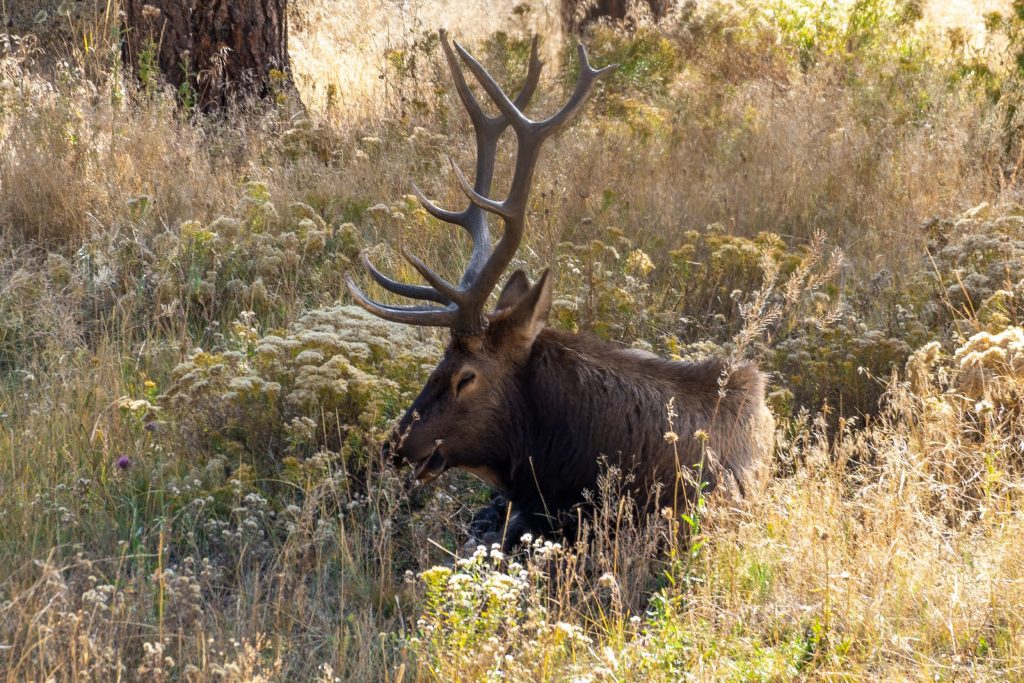
Winter Tips for Rocky Mountain National Park Photography
RMNP is a stunning snowy white wonderland in winter. It’s a peaceful time of the year to visit and photograph Rocky Mountain National Park. Crowds are thin, and you do not need a timed entry permit to visit the park in winter. That said, you will be more limited in where you can go in the park. For example, Trail Ridge Road is closed in winter, and some of the photography destinations that require a bit of a hike to access will be more challenging to reach in the snow.
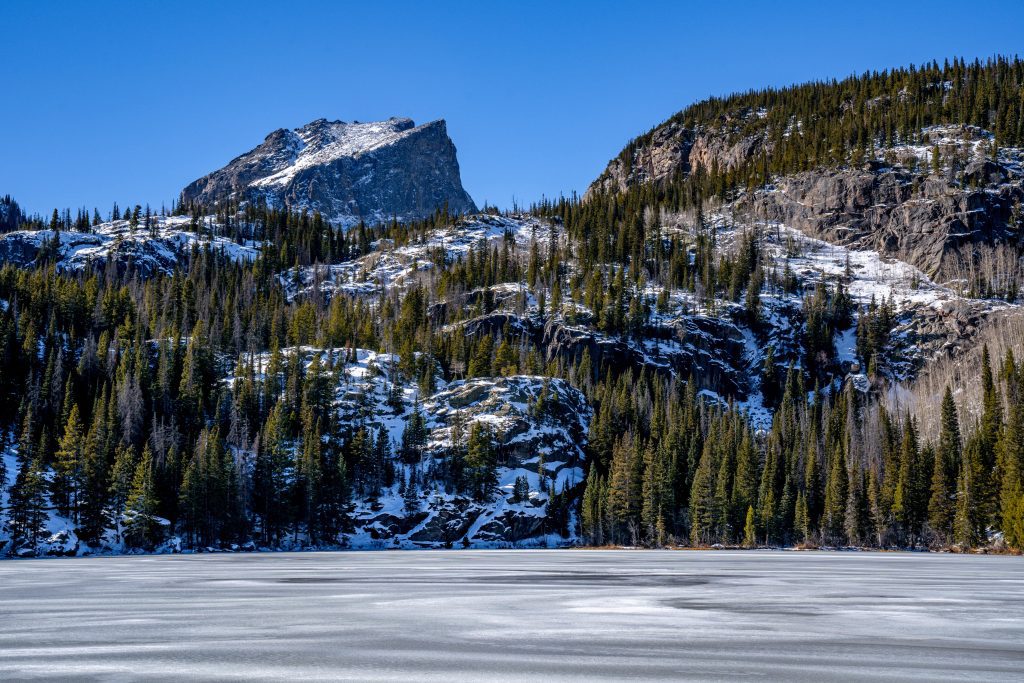
General Tips for Rocky Mountain National Park Photography
- Use compression to make the mountains loom larger in your photos. By slightly zooming in on your frame, you can bring the background closer to the front, creating a more majestic composition.
- The Milky Way is visible from RMNP during the summer months. The best locations for photographing the Milky Way are Lily Lake, Bear Lake, Poudre Lake, and Trail Ridge Road. In general, the further west you go into the park, the less light pollution you will see.
- If your photography destination requires a hike to access, like Emerald Lake or Loch Vale, be sure to only carry as much weight as you comfortably can on a hike.
- The best light for photographing RMNP from the east will be morning when the light hits the mountains to the west. For sunset, views facing east from the west are best for photos of the mountains glowing orange in the sunlight. That said, wherever you are in the park sunrise and sunset will be beautiful!
- Photograph wildlife from your car, where you have protection as well as can use your car as a stabilizer. You can read more about Rocky Mountain National Park wildlife spotting in our guide!
- Look for leading lines using logs or other objects in the environment
- Frame boulders, lily pads, and grasses in your photos to create compelling foreground objects. This adds depth to otherwise flat landscape shots.
- Whether you take photos with a camera or on your phone, in RAW or JPG, check out our Adventurer Lightroom Presets here to easily and quickly take your photos to the next level!

Best Camera Gear for Rocky Mountain National Park Photography
Here’s all of the camera gear we bring with us on Rocky Mountain National Park photography trips:
Camera Bag
I am obsessed with my camera bag. I love that it looks stylish but is still very functional. It’s waterproof, too, which is important when hiking with camera equipment. It fits my 4 lenses, camera, and filters, and even has a laptop sleeve. It’s my go-to for traveling or hiking with my camera gear.
Camera Backpack Strap Clip
I use this camera clip on my 2-liter reservoir hiking backpack for longer hikes. It’s much more comfortable than hiking with it around my neck (though I do keep it on a camera strap as well).
Camera Tripod
This is the tripod we currently use. It’s met all our needs, is fairly lightweight, fits in Tim’s hiking backpack, and is very affordable for the quality.
Camera lenses
I shoot on my Sony a7iii with 4 different types of lenses:
- Wide angle lens: Sony – E 10-18mm F4 OSS Wide-Angle Zoom Lens
- Zoom lens: Sony Alpha 70-350mm F4.5-6.3 G OSS Super-Telephoto APS-C Lens
- Prime 24mm lens: Sony Carl ZEISS Sonnar T E 24mm F1.8 ZA E-Mount Prime Lens
- Prime 24-70mm lens: SONY FE 24-70mm f/2.8 GM Lens Prime Lens
For wildlife photography, we recommend a better zoom lens than the one we currently have. Generally, 400mm or greater is ideal for close-up wildlife shots. We would pick this 200-600mm lens (it’s currently on my wish list!).
Neutral-Density Polarizers and UV filters
We use both a UV filter and a neutral-density polarizer filter depending on the shooting conditions. Make sure you also have the appropriate adapter rings to fit the filters to your various lens sizes.
Remote shutter
A remote shutter is really helpful for reducing the camera shake that comes from manually pressing the shutter. Most of the time you won’t need this, but if you are taking an extended exposure (such as a night sky or waterfall photograph), having a perfectly still camera can make or break your photo. You can also use a remote shutter to take pictures of yourself if your camera doesn’t have a built-in intervalometer.
Lens cloth
When shooting outside in the elements, your photography gear, including your lenses and camera’s sensor, gets exposed to wind and dust. A lens cloth can keep your glass clean between shots.
Memory cards
Don’t forget to pack an SD card (and an extra one too)!
Headlamp
Many of the best Rocky Mountain National Park photography locations are located on hiking trails. If you want to shoot at sunrise or sunset, bring a headlamp with you so you can see while hiking in the dark.
Guided Rocky Mountain National Park Tours
Looking for a guided experience in Rocky Mountain National Park? Check out some of these tours you can book to help you make the most of your time in RMNP without the hassle.
Rocky Mountain National Park Photography FAQs
Where is the best view in Rocky Mountain National Park?
For big, expansive views in Rocky Mountain National Park, you can’t beat Trail Ridge Road. This is where you can photograph the biggest views in the park.
For more closeup landscape photography, we think Dream Lake is the most iconic and picturesque. However, the color change at Lake Haiyaha has made it a particularly special view to photograph after the rockslide in 2022.
Where should you stay at Rocky Mountain National Park?
Here are some recommendations for where to stay in Estes Park:
Luxury
Midrange
- The Historic Crag’s Lodge
- Silver Moon Hotel
- Best Western Plus Silver Saddle Inn
- 4 Seasons Inn on Fall River
- Hotel Estes
Budget
Click here to search for additional hotels in Estes Park or search below!
What should you pack for Rocky Mountain National Park?
Check out our Rocky Mountain National Park packing list and free printable PDF.
What are the entry requirements for Rocky Mountain National Park?
You will need to pay for the park entrance, which is $30 per vehicle for one day or $35 for a week. If you plan to visit and photograph more than 3 national parks in a 12-month period, we recommend getting an annual National Parks pass like the America the Beautiful pass. If you are visiting in the summer, you also need a timed-entry permit.
Final Thoughts on Rocky Mountain National Park Photography
We hope this post makes you more prepared and excited for your Rocky Mountain National Park photography trip! Don’t forget to check out all our RMNP guides to help you plan your Colorado trip!







